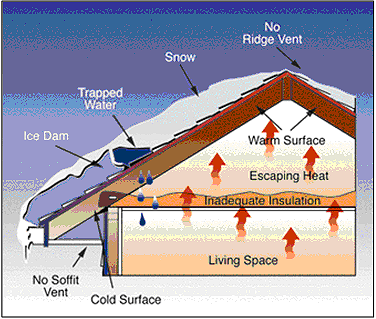Many homeowners in the Washington metropolitan area have experienced a winter storm condition called “ice damming.” Ice dams occur when a sequence of weather conditions take place during a brief time frame.
Due to our relatively mild winters, the Washington and Northern Virginia area experiences this sequence of weather conditions usually only every three to five years.
Below are some commonly asked questions about ice dams and how they could affect your home.
What is an ice dam?
What causes my home to leak?
Ice dam related leaks occur when warm, heated air from the home begins to migrate through the insulation and into the attic area of the house. Without proper ventilation, this warm air collects in the attic area and may warm the underside of the roof decking.
With outside temperatures keeping the top outside layer of moisture frozen, the warm decking melts the bottom layer of ice returning it to a liquid state. This underlayer of water will run down the shingles until it meets the “dam” at the gutter line. With no escape route, the water pools, then backs up underneath the shingles and enters the attic area through nail holes and seams in the roof decking.
Why does my roof not keep the water out?
Shingle roof systems are designed to channel water from the high points of the roof to the lower sections where it should exit the roof either into a gutter system or simply onto the ground. Shingle roof systems are not designed to hold water or prevent water from entering that runs or is blown uphill.
Ice dam related leaks are caused simply because the water could not escape from the shingled roof area. This is not a design flaw with the roofing system or an indication of a poorly installed roof. Ice dams are winter storm conditions which prevent the shingle roof system from shedding water as designed.
What do I do when an ice dam happens?
When an ice dam occurs, the only corrective action that can be taken is to remove the barrier of ice at the gutter line or to remove the ice build-up on the roof area before it melts from underneath. It must be noted that working on a roof under these conditions is extremely dangerous. The risk of injury should always be weighed against the cost of water damage repair. Also, in removing ice from the gutter and roof, you may cause damage to these areas that will require professional repair. Again, the cost of water damage repair may be less than the cost of a roof or gutter repair.
What can I do to prevent ice dams?
While there is no “cure” for ice damming, the following steps can minimize the chance your home will be affected and help prevent ice dams:
- Make sure your attic area has adequate insulation.
- Make sure your attic insulation does not cover your soffit air intake vents. Add soffit vents if your home currently does not have any.
- Make sure your attic area has sufficient air exhaust outlets (gable vents) and that the air flow is distributed throughout the attic space. Peak mounted ridge vents maximize air flow in attic areas.
- Products such as an ice and water protector can be installed at the eaves of the home and in valley areas under the shingles which will prevent water from entering the home unless it dams higher than the protection provides.
- Electric heat tapes can be installed in the gutter system or in extreme cases, can be installed on the lower sections of the roof to melt the ice before dams are formed.
Who is responsible for ice dams and the resulting leaks?
Ice dams are the result of winter storm conditions. Because they are storm related, and not a roof flaw, damage caused by water is not covered by a shingle manufacturer’s or roofing company’s warranty. Remember, roofs are designed to shed water to the ground.
There are many products on the market to improve the capability of established homes to fend off ice dam leaks. Roofing contractors are able to provide an ever increasing number of products and information for re-roofing clients to choose from.
The final responsibility remains with the homeowner when re-roofing to weigh the cost of prevention and protection products against the possible cost of damage if an ice dam leak occurs.

